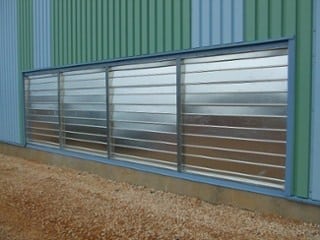Steel Wall Louver Benefits from Moffitt
The wall louver is the most overlooked element of industrial ventilation. Virtually every industrial facility uilizes wall louvers. However most people barely even think about their louvers, let alone details like material, quantity, or blade type. As the experts in natural ventilation, we realize that intake air, and in turn wall louvers, are a vital part of the process of keeping a building cool. At Moffitt, our design engineers can help make sure that you have the right type and number of steel wall louver for your facility.
Natural Air Intake with Steel Wall Louvers
At Moffitt, we offer wall louvers made from a variety of materials. Each type has its benefits and drawbacks, and no one type of louver is appropriate for all facilitates. That said, the most versatile of all wall louvers is the stainless-steel wall louver.
When compared with other types of materials steel louvers often offer the best first cost. Sizes range from 12″ x 12″ to 72″ x 96″. We will also custom fit louvers to meet almost any requirement. If you look at our catalogs, you will find our steel wall louver line under our “Industrial Wall Louver” category. Galvanized steel louvers are standard, but stainless-steel wall louvers are also available. These units are the choice for facilities working in the metal industry as their durability and longevity have given them a proven track record of service.
Steel Wall Louver Blade Types
There are many different options available for wall louvers, but the most important option is deciding on the blade type. Steel Wall Louvers have either adjustable or fixed blade. Fixed louvers have the advantage of durability and require no attention or adjustment should the weather change. They also look sleek and stylish all the time.
On the other hand, you will neet to actively close adjustable louvers when there is excess wind or rain. You can reopen them again when the rain stops, but leaving them open might permit rain to enter. However the louvers themselves are very easy to open and close. Manual chain pulls, hand cranked wheels, and even push-button options are available. For an even easier way to operate the system, you can link banks of louvers can together for single access control.
Free area and pressure drop are the best ways to categorize louvers. Adjustable louvers can open to a full 90° for maximum air movement. Fixed blade louvers, on the other hand, have a free area angle of between 35° to 45°. While this still provides for ample free area and sufficient air movement, it means that less air can move through the unit when compared to adjustable blades. You can either add additional louvers or relocate existing ones to compensate for low airflow.
Additional Options
Moffitt also provides the coefficient of discharge (Cd) ratings for all its louvers. This is a more sophisticated way of measuring how air moves through an opening. The Cd is a key factor when designing a natural ventilation system using the ASHRAE equations. Instead of having to calculate the data yourself, Moffitt saves a crucial step by giving you the previously tested figures. We are one of the few companies that provide a complete coefficient of discharge figures for our louvers.
In addition to choosing blade type, there are a number of cosmetic and functional options also available for our industrial wall louvers. Steel wall louvers can be coated to meet any color requirements. Bird and insect screens help keep out local fauna. You must consider local building codes and even your own building requirements when selecting new louvers. A Moffitt design engineer can help you determine the right louver type for your building. As experts on natural ventilation, we know all aspects of non-powered air movement, including wall louvers. Moffitt Steel Wall Louvers will stand up to the most rugged of conditions. You can see our steel wall louver catalogs to learn more about the available options and functions of our louvers.
Contact a Moffitt representative today. We will help you find the right material, quantity, and blade type for your facility.

